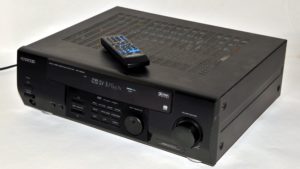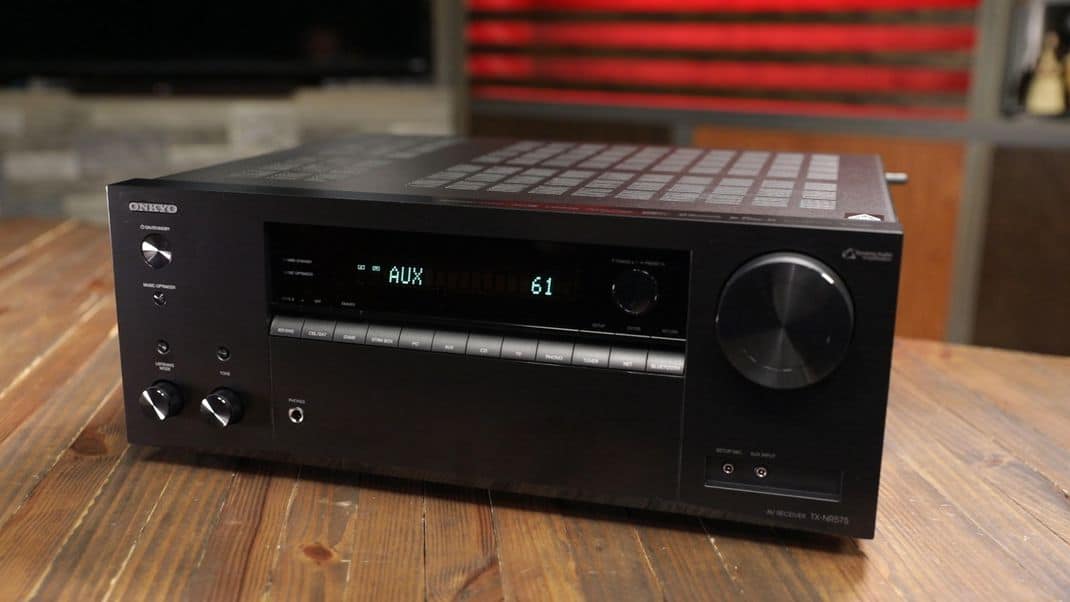An Audio/Video (AV) receiver is a device used to receive and transmit signals for video and audio from a variety of input sources. When connected to a display such as a monitor, television, or projector, the AV receiver plays audio and video from the selected source, which may include a satellite dish, Blu-ray disc player, DVD player, VCR, laptop, mobile device, or a video game console. Multiple input sources can be attached to the receiver simultaneously and the user typically selects the current input source using a remote control or buttons on the receiver itself.
As you might imagine, AV receivers have become indispensable components in modern home theaters, making it easy for consumers to keep all of their electronics connected and available at the same time. Alternative names for AV receivers and their various subtypes include “Home Theater Receiver” and “Digital Media Renderer.” Now that you know the basic definition, here’s a more detailed overview of the main functions, features, and advantages of AV receivers:
Easily Switching Audio and Video Sources
The primary purpose of an AV receiver is to connect all of your digital media devices, displays, and sound sources into a single centralized hardware configuration. Regardless of how powerful the audio source is, it should always be fed through an AV receiver to allow for streamlined source selection and switching. Likewise, the receiver also sends video data from connected devices to the desired output – typically a TV/projector or monitor. Thus, the receiver will usually be connected to a cable box, DVD/Blu-ray player, game console, or DVR. The best AV receivers offer a large number of input ports in combination with style and simplicity to provide a self-explanatory and user-friendly experience.
Picking Up Radio Stations
The majority of AV receivers can also receive radio signals through CB antenna and can, therefore, be used as an AM/FM source. In addition, many newer models include satellite radio receivers that let you pick up services like Sirius and XM radio. However, keep in mind that such radio services often come at a cost, but you may find it worthwhile to purchase satellite radio programming to gain access to exclusive sports commentary and a much larger variety of radio stations than you’d find on conventional radio. Some new receivers can even pick up the recently introduced HD Radio signal format, which provides quality comparable to satellite radio, but without the associated subscription costs.

Decoding Sound Formats
By decoding any audio format that it encounters, a good AV receiver will ensure that you don’t have to mess around with downloading and installing codecs or switching input devices unnecessarily. Whether analog or digital, an AV receiver will take whatever sound input you connect it to and convert it into a signal that can be used by the audio output device. Look for recent model receivers that are capable of decoding the newer DTS Master Audio and Dolby TrueHD audio formats, which are being used on an increasing number of Blu-ray discs.
Amplifying Audio to Power Speakers
An AV receiver will also include at least five amplification channels, each of which can drive power to a component of your surround sound speaker system. This is necessary for incorporating speakers that aren’t self-powered, as is often the case with the larger and more powerful home theater speakers. Thus, having an AV receiver also saves you money on future speaker system purchases, as you’ll be able to opt for the speakers alone, instead of a more expensive bundle that includes a receiver.
Providing a Convenient User Interface for a Well-Rounded Home Theater
Manually disconnecting and connecting different audio and video sources to your display and speaker system can be a major annoyance, especially when you just want to sit down and enjoy some media without a bunch of preliminary steps. An AV receiver eliminates that hassle not only by keeping everything plugged in and connected at all times but also by providing on-screen and on-receiver control options, as well as remote control compatibility.
Plugging Sound System into AV Receiver vs Using the TVs Built-in Receiver
Although many TVs have inbuilt AV receivers, a stand-alone unit typically offers a more robust feature set while also making it easier to access the controls and connections without fiddling around in the back of your TV or other display. Plus, instead of having your TV’s built-in receiver monopolize your sound system, running the audio signal through an AV receiver lets you keep other sound sources connected as well.
Adding DSP Sound Effects and Equalization
Most newer AV receivers include digital signal processors (DSPs) that are capable of modifying the input sound with a variety of equalization presets and effects. Thus, the receiver provides a convenient method for altering the input sound to your liking, without having to separately adjust any setting within the sound system itself. These effects can range from simple playback modes and bass enhancement to more complex audio field simulations that make the sound feel as though it’s being played in a specific kind of environment (i.e. – Hall, Club, Arena, etc.). This is an especially appealing feature for owners of surround sound systems who want to get the most out of their spatial audio setup.
Compatible with Most Popular Connection Types
AV receivers are also preferred home media hubs because of how many different cables and devices they can connect to. Common connection types include HDMI, component video, USB, S-video, composite video, RCA, XLR, and SCART video (mostly found in European AV receivers, but rarely seen elsewhere).
Real-time Video Upscaling and Conversion
Finally, a good AV receiver can also convert video files in real time to improve image quality – a process known as upscaling or “up-conversion.” For example, a video with a native resolution of 480p can be upscaled to 720p.
Can Routing Through an AV Receiver Degrade Video Quality?
The degradation of video quality was once a concern for users of AV receivers, but with the advent of High-Definition Multimedia Interface (HDMI) connections, this is no longer an issue. Almost all newer AV receivers are capable of transferring audio and video with extremely low latency and without any reduction in signal quality.
An Audio/Video (AV) receiver is a device used to receive and transmit signals for video and audiofrom a variety of input sources. When connected to a display such as a monitor, television, orprojector, the AV receiver plays audio and video from the selected source, which may include asatellite dish, Blu-ray disc player, DVD player, VCR, laptop, mobile device, or a video game console.Multiple input sources can be attached to the receiver simultaneously and the user typically selectsthe current input source using a remote control or buttons on the receiver itself.As you might imagine, AV receivers have become indispensable components in modern hometheaters, making it easy for consumers to keep all of their electronics connected and available at thesame time. Alternative names for AV receivers and their various subtypes include “Home TheaterReceiver” and “Digital Media Renderer.” Now that you know the basic definition, here's a moredetailed overview of the main functions, features, and advantages of AV receivers:Easily Switching Audio and Video SourcesThe primary purpose of an AV receiver is to connect all of your digital media devices, displays, andsound sources into a single centralized hardware configuration. Regardless of how powerful theaudio source is, it should always be fed through an AV receiver to allow for streamlined sourceselection and switching. Likewise, the receiver also sends video data from connected devices to thedesired output – typically a TV/projector or monitor. Thus, the receiver will usually be connected toa cable box, DVD/Blu-ray player, game console, or DVR. The best AV receivers offer a large numberof input ports in combination with style and simplicity to provide a self-explanatory and user-friendlyexperience.Picking Up Radio StationsThe majority of AV receivers can also receive radio signals and can, therefore, be used as an AM/FMsource. In addition, many newer models include satellite radio receivers that let you pick up serviceslike Sirius and XM radio. However, keep in mind that such radio services often come at a cost, butyou may find it worthwhile to purchase satellite radio programming to gain access to exclusivesports commentary and a much larger variety of radio stations than you'd find on conventionalradio. Some new receivers can even pick up the recently introduced HD Radio signal format, whichprovides quality comparable to satellite radio, but without the associated subscription costs.Decoding Sound FormatsBy decoding any audio format that it encounters, a good AV receiver will ensure that you don't haveto mess around with downloading and installing codecs or switching input devices unnecessarily.Whether analog or digital, an AV receiver will take whatever sound input you connect it to andconvert it into a signal that can be used by the audio output device. Look for recent model receiversthat are capable of decoding the newer DTS Master Audio and Dolby TrueHD audio formats, whichare being used on an increasing number of Blu-ray discs.Amplifying Audio to Power SpeakersAn AV receiver will also include at least five amplification channels, each of which can drive power toa component of your surround sound speaker system. This is necessary for incorporating speakersthat aren't self-powered, as is often the case with the larger and more powerful home theaterspeakers. Thus, having an AV receiver also saves you money on future speaker system purchases, asyou'll be able to opt for the speakers alone, instead of a more expensive bundle that includes areceiver.Providing a Convenient User Interface for a Well-Rounded Home TheaterManually disconnecting and connecting different audio and video sources to your display andspeaker system can be a major annoyance, especially when you just want to sit down and enjoysome media without a bunch of preliminary steps. An AV receiver eliminates that hassle not only bykeeping everything plugged in and connected at all times but also by providing on-screen and on-receiver control options, as well as remote control compatibility.Plugging Sound System into AV Receiver vs Using the TVs Built-in ReceiverAlthough many TVs have inbuilt AV receivers, a stand-alone unit typically offers a more robustfeature set while also making it easier to access the controls and connections without fiddlingaround in the back of your TV or other display. Plus, instead of having your TV's built-in receivermonopolize your sound system, running the audio signal through an AV receiver lets you keep othersound sources connected as well.Adding DSP Sound Effects and EqualizationMost newer AV receivers include digital signal processors (DSPs) that are capable of modifying theinput sound with a variety of equalization presets and effects. Thus, the receiver provides aconvenient method for altering the input sound to your liking, without having to separately adjustany setting within the sound system itself. These effects can range from simple playback modes andbass enhancement to more complex audio field simulations that make the sound feel as though it'sbeing played in a specific kind of environment (i.e. – Hall, Club, Arena, etc.). This is an especiallyappealing feature for owners of surround sound systems who want to get the most out of theirspatial audio setup.Compatible with Most Popular Connection TypesAV receivers are also preferred home media hubs because of how many different cables and devicesthey can connect to. Common connection types include HDMI, component video, USB, S-video,composite video, RCA, XLR, and SCART video (mostly found in European AV receivers, but rarely seenelsewhere).Real-time Video Upscaling and ConversionFinally, a good AV receiver can also convert video files in real time to improve image quality – aprocess known as upscaling or “up-conversion.” For example, a video with a native resolution of480p can be upscaled to 720p.Can Routing Through an AV Receiver Degrade Video Quality?The degradation of video quality was once a concern for users of AV receivers, but with the adventof High-Definition Multimedia Interface (HDMI) connections, this is no longer an issue. Almost allnewer AV receivers are capable of transferring audio and video with extremely low latency andwithout any reduction in signal quality.
